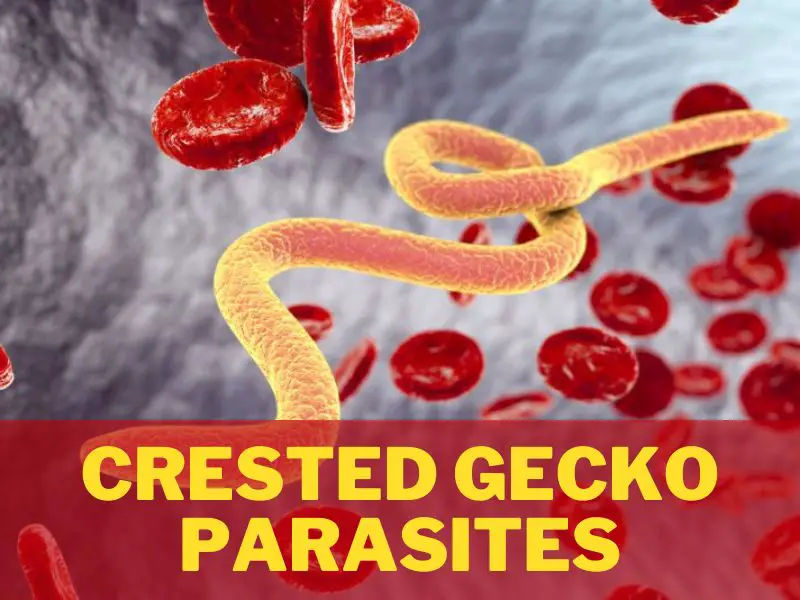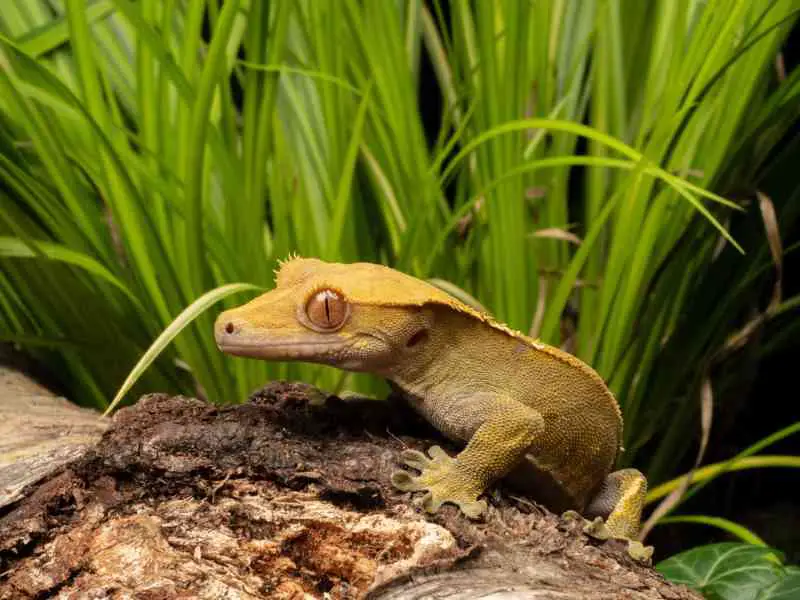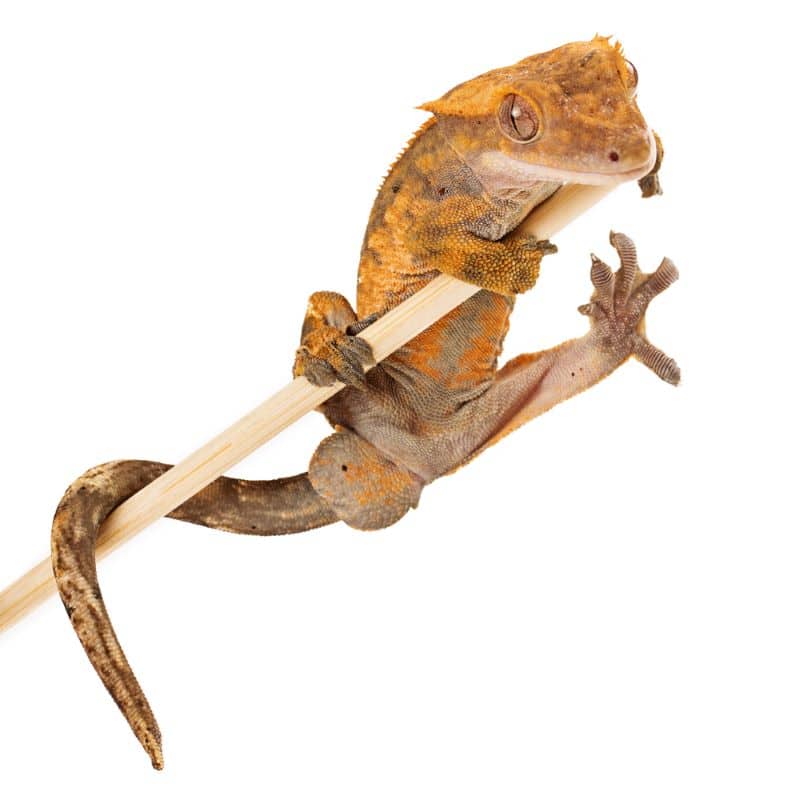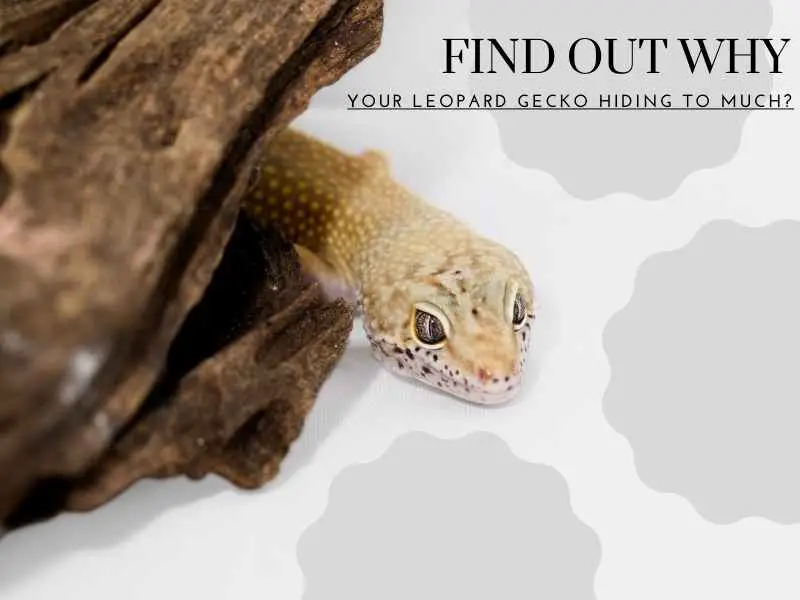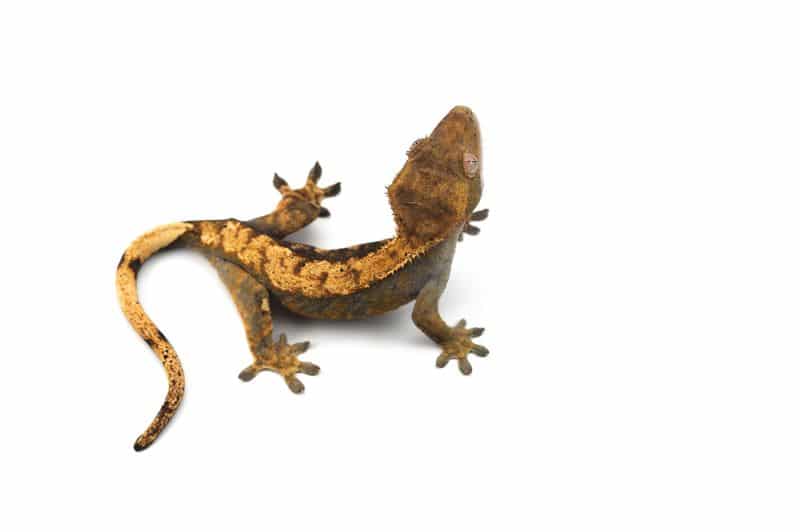Crested Gecko Mealworms: Feeding Dried vs Live (Nutrient Info)
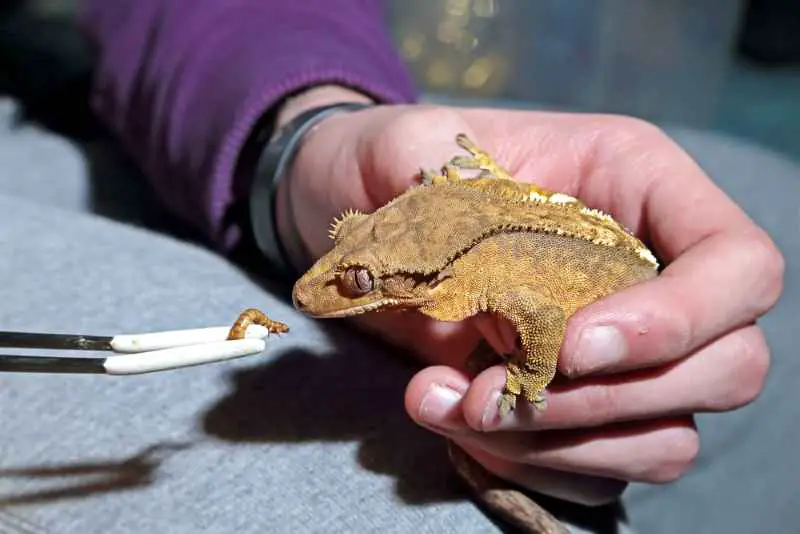
Crested Geckos love their mealworms, though for some of us the ‘live food’ option can make us a little squeamish or simply be a bit of a chore to maintain. With that in mind, are dried mealworms just as good?
Live mealworms are definitely better, as the fresh worms will help to keep your Crested Gecko hydrated and they are less likely to reject live food than they are the dry alternative. Dry mealworms have less nutrition, as well, but they do store longer and make for excellent treats — provided that your crested gecko likes them.
There’s more to it, of course, and in the first half of this article we’re going to extoll the virtues of live foods and give you some important feeding tips that can help to ensure that your crested gecko is lively and happy from getting the proper nutrition that they need.
After that, we’ll compare live vs. dried, and give you some tips on this option as well. By the time we’re done, you’ll have all the facts about both to help you decide if those dried mealies are worth keeping around.
Without further ado, let’s talk about mealworms, your crested gecko, and what you need to know!
Contents
What are mealworms
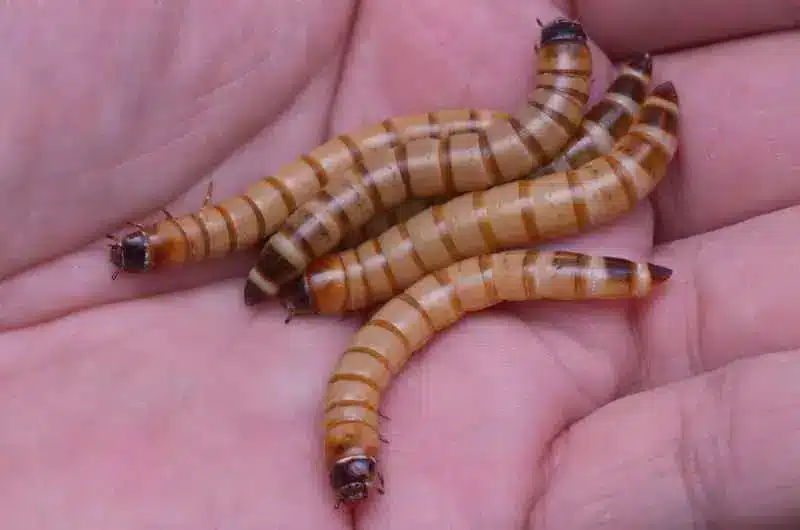
There’s a beetle, known in scientific circles, as the Tenebrio molitar, and commercial mealworms are simply the larval form of this beetle. As they are easy to raise and the larval stage can last anywhere from 4 months to a year (resulting in small to large mealworms), they are a popular choice for feeding fish, birds, and reptiles.
Can crested geckos eat mealworms?
Yes, your crested gecko can indeed eat mealworms, and they really seem to love these beetles-to-be. As far as your crested gecko and live foods are concerned, you also have other choices if you don’t want to give them mealies.
Crested geckos also like superworms, waxworms, silkworms, nutrigrubs, and even crickets, just to name a few more foods that they like. While there are more things that they can eat, this gives you a nice starting point so that you can mix your gecko’s diet up a little so that they’ll always look forward to mealtime.
Should they eat mealworms?
Yes! Mealworms should be a regular part of your crested gecko’s diet and you’ll want to dust them with a calcium supplement for reptiles, which contains vitamin D3. Vitamin D3 is normally produced when a gecko is basking outside in the sunlight, but indoor lizards need a helping hand to ensure that they get this vitamin.
By dusting mealworms, you can do exactly that, and having an ultraviolet lamp on during the daytime in your crested geckos cage will also allow them to bask a little and produce some D3 on their own. Your gecko will be happy and healthy and you’ll rest a little easier, knowing that they’re getting their vitamin D3.
How many mealworms should I feed my gecko?
That’s going to depend on the size and the age of your gecko. The best way to approach it is by starting off with a ‘test sample’ of 6 mealworms, seeing how many they eat, and if you think they would like more, then there is a simple size rule that you can use.
For every inch of length, give your gecko 2 mealworms. You can give them a little more if they will eat them, but you should consider this the absolute minimum when those mealworms are on the menu.
Baby crested gecko vs adult
Baby crested geckos don’t really eat a whole lot of mealworms, with 3 or 4 worms being the typical amount that you would give to a very small and young juvenile. The ‘2 worms for every inch of length’ rule is going to be your best approach, however, to ensure that you don’t underfeed them.
Adults can grow to be about 8 inches long, so if your crested gecko is fully grown, then you would be feeding them up to 16 mealworms in one go.
That said, with larger adults, it’s really better to mix in some crickets with those mealies, for more nutrition, a little variety, and the ‘joy of the hunt’ that your gecko will have chasing and devouring their prey.
In either case, make sure that you dusting all of the insects with your favorite calcium and vitamin d3 supplement to ensure that your gecko – baby or adult – is getting a burst of vital nutrition with every insect they catch!
How to feed mealworms to your crested gecko
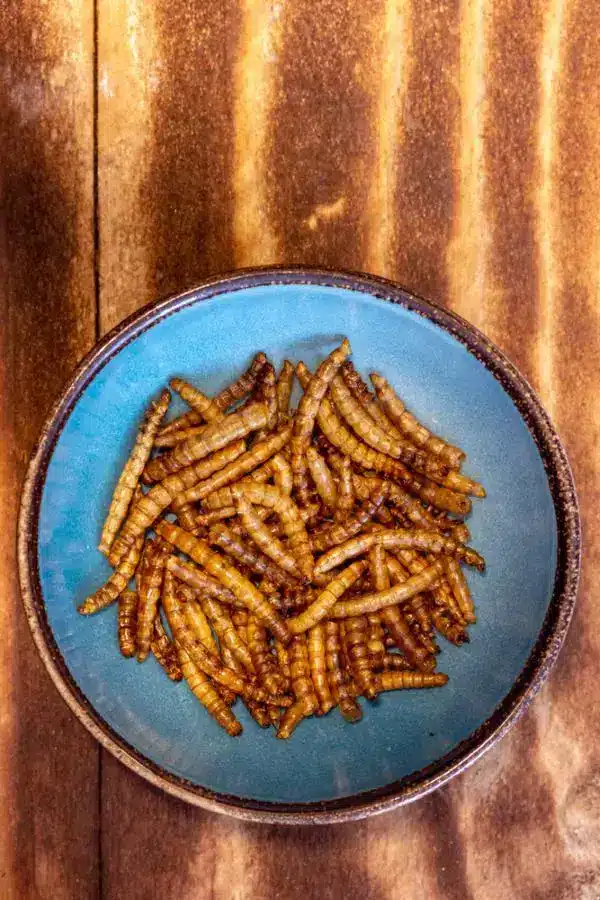
While about 85% of your crested geckos diet is going to consist of live prey and vitamin-packed fruits, such as mango, the other 15% should be veggies. It just so happens that mealworms like certain vegetables, such as squash, are also good for your gecko.
To make sure that they get their veggies and so that your mealworms will stay alive longer, put a little squash in your blender to make it have a ‘smoothy’ consistency and then place this in a small, shallow bowl, and drop the mealies into it. The bowl should be shallow enough that they won’t drown.
Your mealies will eat some of the squash when they are hungry, keeping them alive, and your crested gecko can enjoy a feast of squash and live, wriggly mealies!
Throwing out the remaining live mealworms – safely
Once you take those mealworms out of the fridge, the warmer temperature will wake up the beetle larvae and they will actively begin their transformation into the beetles that they are meant to be – if you let them.
Disposing of remaining, uneaten mealworms needs to be done properly, as simply tossing them in the bin is going to be a recipe for ‘surprise beetles’ and you definitely don’t want that surprise at home or to inflict it on whoever ends up with your trash.
A simple way to avoid this is available in your home – the freezer. Simply invest in a small Tupperware container that you can drop the uneaten mealies into and freeze them for a minimum of 48 hours before disposing of them.
This should help to minimize any unintentional environmental impact from feeding these beetle larvae to your gecko and also help you to avoid finding beetles in the house – which is definitely a mistake you’ll only make once!
Can crested geckos eat dried mealworms?
Now that we’ve covered live mealies, what about those handy dried ones? Well, your crested gecko can indeed eat these, provided that they will. Your crested gecko is instinctually wired to eat live worms, but placing the dried ones in with their fruits should tempt them to take a nibble and after that, they will start looking for them.
The dried mealies are fine for them to eat and they can be quite convenient, though they are not considered to be as nutritious or as appealing as a regular food source. Let’s look at a quick comparison of the pros and cons and this should give you a better understanding of the contrast.
Advantages of dried mealworms
Dried mealworms definitely have their perks, so here’s an at-a-glance summary of the pros of keeping these gecko-snacks in stock at home:
- Shelf life – Dried mealworms have a shelf life of approximately 2 years, and even longer airtight containers that are refrigerated. Live mealies, however, can stay in the fridge for about 2 weeks, requiring regular trips to the pet store if you aren’t raising them at home.
- They won’t die in the bowl – Dried mealies are already dead, so you can put them in a bowl in your gecko’s enclosure to be eaten at leisure. Live mealworms can die on you, though adding a couple of thin apple slices will typically keep them alive until your gecko decides to eat them.
- Easier for some owners – Some of us are squeamish about feeding live prey to our pets or simply don’t like keeping live animals in the refrigerator. Dried mealies don’t wiggle and you can store them on the shelf, which definitely counts as a perk.
Disadvantages of dried mealworms
Every choice has its caveats, and dried mealworms are certainly no exception. Let’s look at the disadvantages of dried mealworms when compared to live ones.
- Nutritional profile – Dried mealworms don’t pack the same nutritional punch. For one thing, they are dehydrated, so your gecko doesn’t get the water content and resulting in extra hydration. For another, their stomachs are empty, so the contents of their meals won’t be part of your gecko’s diet either.
- Overall appeal – Crested geckos will usually eat all of the live mealies, but there is no guarantee that they will find the dry, dead mealies anywhere near as appealing as the wriggly live ones. Think of it like this: would you rather have beef jerky or a fresh and juicy steak? It’s a little like that from your gecko’s perspective.
Throwing them away after expiration important
Most crested geckos will learn to love their dried mealies, but since they are dehydrated and can last for up to 2 years, it’s easy to forget that they do indeed expire. A great way to avoid accidentally feeding gecko expired mealies is to invest in a black marker and to write the expiration date in bold, black letters.
If you have more than one container, put the one or more that expire later in the back, so that you are always using the one with the lowest shelf-life first. It’s a simple method, but an effective one, but you need to do one more thing – throw away expired containers as soon as you notice them.
Expired mealworms can attract harmful bacteria that can make your crested gecko very sick, so it’s vital to throw away expired dried mealworms by the proper date or if you aren’t sure, then to throw them away immediately and replace them with dried mealworms that have a clear expiration date.
By marking them yourself you’ll make a mental note of when they’ll expire, and this should minimize or even eliminate this pitfall completely so that your crested gecko is always getting their mealworms while they are at their safest and most delicious – it’s easy to do and a win-win situation for the both of you.
Other feeder insects besides mealworms for your crested gecko
Mealworms aren’t the only game in town when it comes to live or dried foods that your crested gecko can enjoy. More importantly, you want to get into the habit now of giving them a little variety. Even if mealworms are their favorite food, switching up their menu helps to encourage your gecko to always eat.
After all, you wouldn’t want to eat pizza every day for the rest of your life, would you? Thankfully, keeping their diet fresh and interesting is quite easy to do, and we’ll even give you some examples so that you can create a basic menu to build on for your gecko to keep mealtimes exciting. Here’s a starting menu:
- Mealworms (of course)
- Waxworms
- Superworms
- Crickets
- Nutrigrubs (Black soldier fly larvae)
- Dubia roaches
That’s just a sampling, but don’t forget that the ideal diet for your crested gecko should be about 85% insects and fruits (such as banana, mango, or pumpkin) and about 15% veggies – with these being served finely chopped or better yet, in an easy-to-eat ‘smoothie-like’ consistency.
Example veggies include butternut squash, bell peppers, okra, or button mushrooms, and if you are going with the ‘smoothie servings’.
A pro-tip that can save you time is to make a batch every week by blending up the veggies (maybe even with a little fruit) and pouring the mix into an ice tray, freezing it, and later adding a cube or two to its own bowl to quickly melt and be enjoyed by your gecko. If the bowl is shallow, add live mealies when it thaws and it’s perfect!
The final verdict – Live is better but dry works in a pinch!
So, there you have it! Live mealworms are definitely the best in my opinion, though dried ones store more easily and take the ‘yuck’ factor out if you don’t like feeding live prey, storing them in your fridge, or the frequent trips to the pet store.
Keep in mind, you can do a little homework on raising live mealies at home and your gecko will definitely love this, though ultimately that will be up to you. Now that you have the facts, you can make some feeding strategies of your own, and your crested gecko will be happy, healthy, and well-fed indeed!
Finally, feedings should be done once or twice a week and for best results, remove perishable food and uneaten insects the next morning for proper disposal. It takes some getting used to, but once you have a strategy in place and a disposal routine, giving your crested gecko the perfect diet is really very simple.
Use the tips that we’ve shared today and you’ll soon see it for yourself firsthand!
